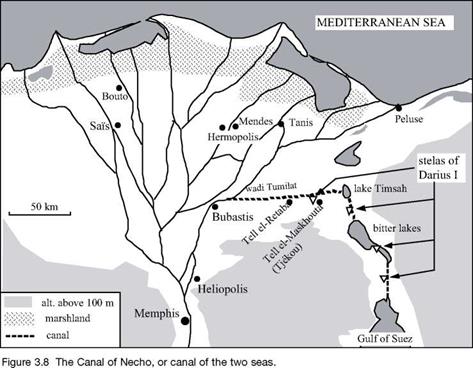The great accomplishments of Egypt in the first millennium BC: from the last pharaohs to the Persians
Who dug the first “Suez Canal”?
Egypt had a long tradition of maritime commerce with countries on the shores of the Red Sea (in particular with the country of Punt, situated approximately east of Sudan and north of Eritrea). The port of Mersa Gawasis was founded in about 1900 BC under Amenemhat II (Middle Empire), somewhat below the 27th parallel (therefore a bit to the north of Thebes). Merchandise is carried by land to or from Thebes through arid valleys, typified by the wadi Hammamat.
One can therefore readily appreciate the interest in a direct maritime link between the Nile and the Red Sea. Such a link was in fact realized though the valley of the wadi Tumilat with an east-west orientation. The remains of the canal were still visible in the 19th century, as described by Marice Linant de Bellefonds (1799-1883):
“More than forty years ago one could see, in the northern portions of today’s wadi Toumilat, the remains of an ancient canal that had rather small dimensions; it came from the west and flowed to the east along the desert and cultivated lands…. Near Tel-Retabee, this canal joined another much larger one, at a place called Ras el Wadi. this was the principal ancient canal..
It is there that the other canal from the northern portion joins the latter, which is much larger
30
and looks to be a very old and well built canal. u
All of the classic authors mention the existence of this very ancient and large-scale link. Certain of them (Aristotle, Strabo, Pliny) attribute the paternity of the canal to a pharaoh whom they call “Sesostris.”[115] [116] But archaeology clearly rules out the existence of such a communication link in the middle or new Empire. At best, one may consider the possibility that in the new Empire a small canal was constructed to transport stones from the Nile to the monuments constructed by Ramses II at the site known today as Tell
el Retaba. This is surely the small northern canal of the text cited.[117]
33
Modern studies[118] show that it is once again Herodotus who gives us the most precise information. He situates the real beginning of the construction of the large canal during the reign of the Pharaoh Necho II, of the Saite Dynasty, who reigned in about 600 BC. This pharaoh, like most of his predecessors, pursued a policy of expansion toward the east, taking advantage of the fall of the Assyrian Empire. He builds a fleet of boats and embarks on an African expedition. Necho II founds the city of Tjekou, on the site of today’s Tell el Maskhouta, some fifteen kilometers to the west of the present Ismailia.[119] [120] Most of the canal was therefore built in that period (at least as far as Tjekou).
Two independent sources, that we will cite below, indicate the digging of the canal was not effectively ended until a century later, about 5009 BC, by order of the Persian sovereign Darius I.
Here is what Herodotus says:
“The son of Psammetichus was Necos, and he too became king of Egypt, and he was the first to attempt to dig a canal into the Red Sea; Darius the Persian was the second to dig it.”33
According to this author, some 120,000 workers were employed for the task by Necho. In 1866 Ferdinand de Lesseps, during his preliminary reconnaissance for construction of the Suez Canal, recognizes the traces of this ancient canal, well to the east of the vestiges found by Linant de Bellefonds.[121] At Kabret, 130 km from Suez on the isthmus of the same name, de Lesseps discovers a stela of pink granite engraved with the name of Darius, and with the following inscription in several languages:
“the king Darius declares: I am a Persian. From Persia, I took Egypt. I ordered this canal to be dug, from a river of the name of Nile, that flows in Egypt, to the sea that comes from Persia. Therefore, this canal was dug, as I had ordered, and boats go from Egypt, by this canal, toward Persia, as it pleases me.”[122]
The Persian’s strategic interest in this canal is obvious. But it is clear that Darius wrongly attributes the conquest of Egypt to himself, since this conquest was in fact accomplished by his predecessor Cambyse. Therefore it is not surprising that he also exaggerates his own role in the digging of the canal. Necho’s channel may have become clogged with silt or sand in the era of the sovereign Darius, who therefore would have re-excavated it. It is also possible that the canal project undertaken by Necho was simply not completed. In any case, three other stelas carrying the name of Darius will be discovered along the route of the canal, the most westerly being at Tell el-Mashkhuta (Figure 3.8).
|
|







Leave a reply